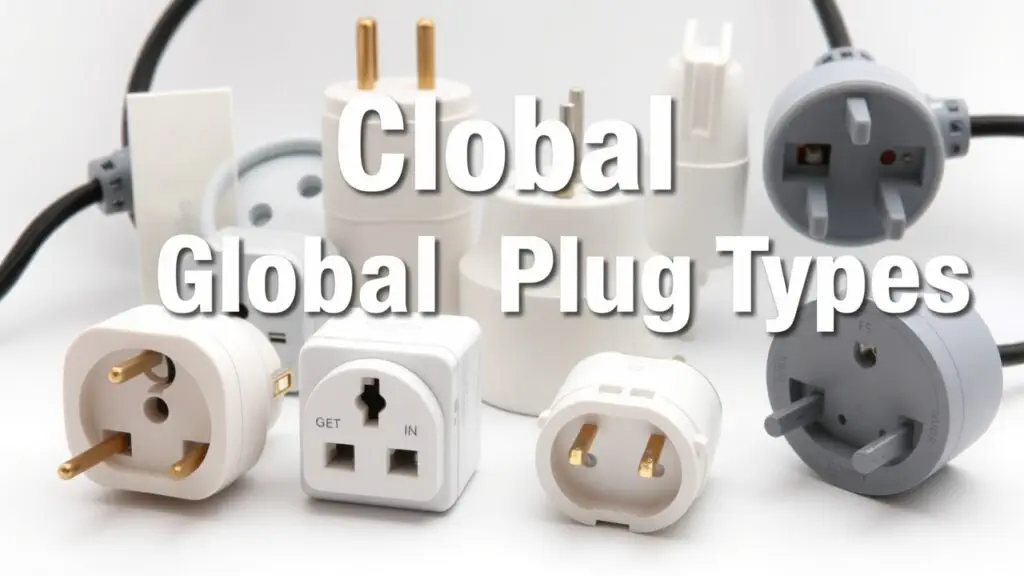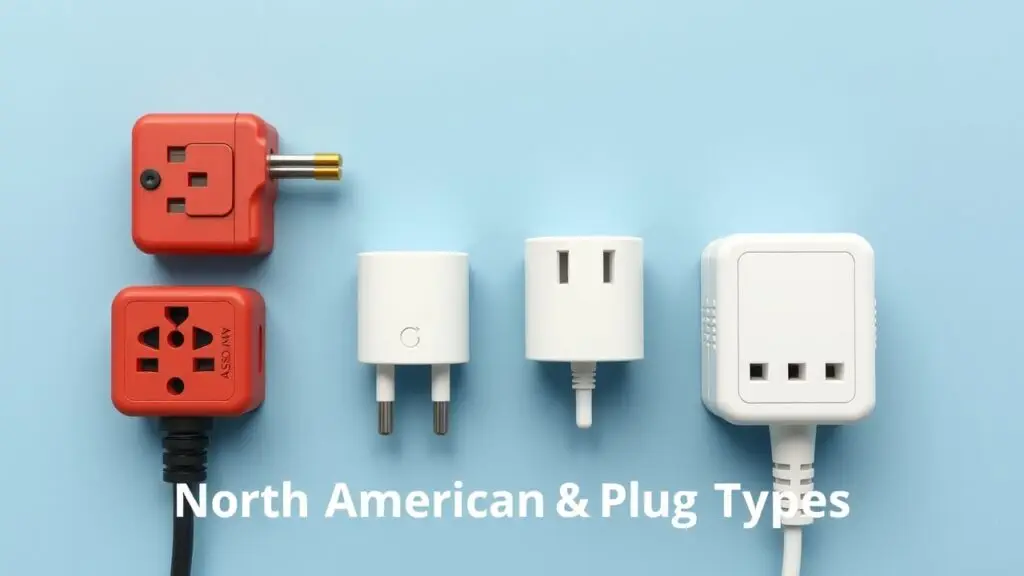Types of electrical plugs vary globally. This guide covers types A-N, explaining differences in voltage, amperage, and compatibility, ensuring safe international electrical device use.
What Are Electrical Plugs and Why Do They Matter?

Electrical plugs are key devices that connect appliances to power sources through outlets. Their main job is to allow electricity to flow from a supply line into devices like computers, kitchen gadgets, and other electronics. Knowing about different plug types is important for several reasons.
First, safety is a major concern. Using the right plug type can help prevent electrical hazards like shocks or fires. Each area has specific standards for plugs and sockets that keep users safe with proper voltage levels. Plus, if you travel internationally, you might run into compatibility issues if you don’t know what adapter or converter your device needs. This knowledge is key to making sure all your electronics work without damage during your travels.
How Many Types of Electrical Plugs Exist Worldwide?
There are many types of electrical plugs around the world—specifically 15 recognized designs labeled from Type A to Type N by the International Electrotechnical Commission (IEC). Each type has its own unique features that suit different voltage ratings and amperage capacities based on various regions.
The range in plug designs reflects the differences in wiring systems across countries:
- Type A: Used mainly in North America, it has two flat parallel pins.
- Type B: Also in North America, this type has two flat pins plus a grounding pin.
- Type C: Common throughout Europe, featuring two round pins.
- Type D: Used in India with three large round pins.
- Type E: Found in France and Belgium, it has two round pins with a hole for grounding.
- Type F: Standard in Germany with two round pins and two earth clips.
- Type G: Used in the United Kingdom, known for its three rectangular prongs.
- Type H: Used in Israel, it features three flat prongs forming a triangle.
Understanding these different types helps travelers and consumers figure out which adapters they need based on socket compatibility at their destinations. Knowing about these options can save you from hassle and ensure safety while using your devices.
North American Plug Standards (Type A & Type B)
North America mainly uses two types of electrical plugs: Type A and Type B. These plugs are part of the National Electrical Manufacturers Association (NEMA) standards. Knowing about these plug types is important for travelers, movers, and anyone using electronics in North America.
What Is a Type A Plug?
A Type A plug has two flat parallel prongs. It’s often called a two-prong plug. This type is non-polarized, which means it can be inserted into an outlet either way. While it’s simple to use, it lacks safety features found in other plugs. The NEMA 1-15 standard controls this plug, which works at 120 volts and handles a maximum of 15 amps.
You can find Type A plugs in places like the United States, Canada, Mexico, and parts of Central America. Since they don’t have grounding features, they should only be used with devices that don’t need grounding protection.
What Is a Type B Plug?
The Type B plug has three prongs: two flat blades like the Type A and one round grounding pin below them. This design makes it a polarized three-prong plug that meets the NEMA 5-15 standard. The grounding pin adds safety by providing a path for excess electricity to ground safely.
Type B plugs also operate at 120 volts and up to 15 amps but offer better protection against electrical faults because of their grounded design. They’re commonly used in homes and businesses across North America where reliable power sources are needed.
European Plug Variants (Type C, E & F)
Europe has different electrical plug designs by country or region—mainly Types C, E, and F—that match various voltage needs and safety standards.
What Is a Type C Plug Used For?
The Type C plug has two round pins that are spaced apart and doesn’t include any grounding feature; this makes it ungrounded. It’s known as the Europlug or “CEE 7/16.” You can use it in many European countries like France, Germany, Spain, and Italy.
This type is mainly for low-power devices such as chargers or small appliances that don’t need high wattage or grounding protection. Users should check compatibility before plugging into local sockets because some outlets may not fit this type properly due to size differences among countries.
How Do Types E and F Differ From Each Other?
Types E and F both have similar round pins but differ in how they provide grounding:
- Type E: This type features one male pin for the earth connection with two holes on either side.
- Type F: Known as Schuko plugs, these have metal clips on the sides that secure them when plugged into compatible sockets to ensure proper earthing during use.
Both types work with voltages ranging from 220V to 240V, making them suitable for many areas throughout Europe, though socket compatibility can vary by country.
UK-Specific Plugs (Type G)
In Britain and Ireland, they use “BS1363” standards that govern all aspects of electric supply systems. This includes wiring regulations from government agencies ensuring public health and safety concerning energy consumption practices today!
The UK plug uses a rectangular-shaped fused three-pin configuration which allows safe operation under heavy load conditions commonly found in households using multiple electronic gadgets needing higher amperage than typical items would require!
Global Overview by Region or Country Usage Examples
North America
In North America, Type A and Type B plugs are the most common. These plug types are widely used in both the United States and Canada.
- Type A has two flat parallel pins. Type B adds a grounding pin for safety.
- Both types operate on a voltage rating of 120V and use a frequency of 60Hz, standard in this region.
Europe
Europe has many plug types, but Types C, E, and F are very common across various countries.
- Type C, called the Europlug, works with various sockets. It’s often found in devices needing lower power.
- Types E and F are similar but have different grounding methods. They provide strong connections for more powerful appliances.
Countries like France mainly use Type E plugs, while Germany uses Type F plugs. Most European countries run on a voltage standard of 230V.
United Kingdom
The UK uses a unique three-pin system known as Type G.
- This type has rectangular prongs arranged to form a triangle shape, ensuring stability when plugged into sockets.
- The UK also operates on a voltage of 230V and has strict safety rules to keep electrical installations safe.
Australia/New Zealand
Australia has specific plug designs that meet AS/NZS standards, which include variations for New Zealand.
- The Australian plug features two flat angled pins shaped like an inverted V along with an earthing pin.
- Like other regions, this area typically uses a voltage rating of about 230V for household electricity.
Asia
Asia features several distinct plug types:
- In Japan, you mainly find Types A and B, which work at lower voltages around 100V.
- In China, Type I is the standard and supports higher voltages usually around 220V, suitable for modern appliances.
These differences show how each country shapes its electrical systems to fit local needs and resources.
South America
Brazil stands out in South America due to its own approach to electrical plugs with multiple standards such as NBR14136.
This includes various styles like Type N (the newer standard) along with older types still in use—highlighting Brazil’s effort towards better international compatibility in its power supply systems.
Understanding the global variety in electrical plug designs helps travelers avoid problems with different regions’ power systems. Each area’s standards reflect history and technology aimed at ensuring safe usage across diverse settings worldwide.
Understanding Voltage and Frequency
What is Voltage and Frequency?
Voltage is the force that pushes electric current through a wire. It’s measured in volts (V). Countries use different voltage ratings for their power supply, typically from 100V to 240V.
Frequency tells us how many times the current changes direction each second. This is measured in hertz (Hz). Most areas operate on either 50 Hz or 60 Hz. This difference can affect how some appliances work because certain devices are made for one frequency only.
Knowing about voltage and frequency is really important when traveling or moving to another country. If you use an appliance that doesn’t match the local voltage or frequency, it could break.
The Dangers of Mismatched Voltage and Frequency
Using devices with different voltage ratings can be very risky. You might face electrical hazards or find your appliances won’t work right. Devices made for lower voltages might get too hot if plugged into higher voltages, leading to fires or breaking down completely. Using equipment at the wrong frequency can make motors run poorly or fail.
Electrical shock is also a real danger when using plugs that don’t match sockets in different regions. Always check that everything matches before plugging in devices to stay safe.
Voltage Converters vs. Adapters: Key Differences and When to Use Each
When traveling internationally, it’s key to know the difference between travel adapters and power converters:
- Travel Adapters: These let your device’s plug fit into foreign outlets but don’t change the voltage.
- Power Converters: These lower high-voltage electricity so low-voltage devices can work safely abroad.
Be careful when choosing what you need based on your electronics’ specs. Check if your device needs just an adapter because of its plug shape or if it needs a converter due to how it works!
Selecting the Right Adapter: A Step-by-Step Guide

When you travel internationally, picking the right adapter is super important to keep your devices charged. There are different kinds of electrical plugs used worldwide. Knowing which travel adapters you need can save you from stress and confusion.
Identifying Your Device’s Plug Type and Voltage/Frequency Requirements
First, check what kind of plug your device uses and its voltage needs. Most electronic devices have a label that shows their voltage ratings, which usually range from 100V to 240V. Amperage ratings are measured in amps. Devices with grounded plugs need three prongs for safety, while ungrounded plugs use two prongs. This info helps you know if your device will work safely abroad without getting damaged.
Determining the Outlet Type in Your Destination
Every country has different outlet types based on local standards. For example, North America mainly uses Type A or B outlets. Meanwhile, Europe often uses Types C or E/F outlets. Checking outlet types by country before you go will help you understand what kind of plug compatibility you’ll need at your destination.
| Country/Region | Common Plug Types |
|---|---|
| United States | A, B |
| Canada | A, B |
| United Kingdom | G |
| Australia | I |
| European Union | C, E/F |
Choosing the Correct Adapter: Matching Plug Type and Voltage/Frequency
After figuring out your device’s needs and the outlet type where you’re going, it’s time to select the right power adapter. Make sure that any travel adapters match both the shape of your plug and the voltage requirements; some areas may need a voltage converter for high-wattage items like hair dryers or irons.
Compatible plug types usually fall under NEMA (North American) or IEC (International Electrotechnical Commission) standards based on your travel location.
Safety Precautions When Using Adapters
Using electrical adapters requires some safety precautions to avoid problems like overloading circuits or damaging devices:
- Inspect for Damage: Always check cables and connectors for wear before using them.
- Avoid Overloading: Don’t exceed wattage limits when plugging multiple devices into one adapter.
- Use Surge Protectors: Think about using surge protectors in places with power fluctuations.
These tips help keep you safe from electrical hazards while traveling.
By following these steps—checking device needs first then matching them with local standards—you’ll be more prepared for smooth connectivity wherever your travels take you!
Electrical Safety Precautions: Preventing Accidents
Electrical safety is super important to avoid accidents and keep yourself safe while using electrical plugs. Knowing the dangers linked to electricity can help prevent problems like electrical shock or fires.
General Electrical Safety Tips
To keep electrical safety in check, follow these important dos and don’ts:
- Never Force Plugs: Always make sure that the plug fits easily into the socket. Forcing it can break both the plug and socket.
- Inspect Cords Regularly: Look at cords for damage before using them. A damaged cord can lead to electric shocks or even fires.
- Avoid Overloading Circuits: Don’t plug too many devices into one outlet. It can cause overheating and might lead to a fire. Use power strips carefully.
- Follow Electrical Codes: Stick to local electrical codes that help keep you safe from hazards.
These steps can really lower your risk of running into electrical hazards at home or while you travel.
Safe Use of Adapters and Converters
When using travel adapters or voltage converters, it’s key to check if they fit your devices well. Not all adapters work with every electronic device; some only change the plug shape but not the voltage.
Before plugging in anything:
- Make sure your adapter matches the type of plug used in the country you’re visiting.
- Check if it supports the voltage needed for your electronics (like 110V or 220V).
- Think about getting a universal travel adapter if you go to different countries a lot.
Using the wrong adapter could damage your devices or create unsafe situations like overheating.
Grounding and its Importance
Grounding is an essential part of electrical safety that helps protect you from shocks caused by faulty appliances. Grounded plugs have an extra pin that connects to grounding wires in buildings, giving a safe path for excess electricity during faults.
Key points about grounding:
- Grounded Plugs: These usually have three prongs—two flat ones for live connections and one round prong for grounding.
- Importance: Grounding protects people from electric shocks by directing stray currents safely away from them.
Always use grounded outlets when you can, especially for powerful appliances like refrigerators or computers.
What to Do in Case of an Electrical Shock?
If someone gets shocked by electricity, it’s important to act fast:
- Do Not Touch Them Directly: If they’re still connected to the source of electricity (like touching a live wire), don’t try to rescue them until it’s safe.
- Disconnect Power Source: Turn off power at circuit breakers if you can do so safely.
- Call Emergency Services: Get medical help right away; even minor injuries need attention since internal injuries might not be visible.
- Perform First Aid if Trained: If you know first aid methods like CPR, give care until help arrives.
Knowing these steps keeps you prepared for emergencies involving electric shocks while reinforcing overall awareness around electrical safety practices related specifically to various types of plugs used worldwide.
FAQs About Types of Electrical Plugs
What is the difference between a travel plug adapter and a converter?
A travel plug adapter allows you to connect your device to a different socket type. It doesn’t change voltage. A converter changes the voltage, making it safe to use devices designed for different electrical systems.
Which plugs are used in Australia and New Zealand?
Australia and New Zealand primarily use Type I plugs. These have two flat pins angled at 30 degrees and a grounding pin.
How do I find the right plug for my country?
You can check online resources or electrical safety websites for information on plug types used in specific countries. Look for charts that list common plug types by region.
Are there safety standards for electrical plugs?
Yes, several organizations set safety standards for electrical plugs worldwide. Examples include UL (Underwriters Laboratories), CE marking in Europe, and SAA in Australia. These certifications ensure product safety.
Can I use my device with different plug types?
Yes, you can use your device with various plug types if you have the appropriate adapter. Ensure your device is compatible with local voltage and frequency to avoid damage.
Additional Information on Plug Types
- Type J Plugs: Common in Switzerland and Liechtenstein; they have three round pins.
- Type K Plugs: Used mainly in Denmark; they feature two round pins and an earth pin.
- Type L Plugs: Found in Italy; this type has three round pins arranged in a line.
- Schuko Plugs: Widely used across Europe; they have two round pins with side grounding clips.
- Class I vs. Class II Plugs: Class I plugs require grounding for safety, while Class II plugs are double insulated without grounding.
- Ground Fault Circuit Interrupter (GFCI): This outlet type protects against electric shock by cutting off power when it detects an imbalance.
Understanding International Plug Standards
- AS 3112: Australian standard for plugs.
- BS 1363: British standard that defines the UK plug.
- CEE 7/4: Standard for Schuko plugs found in Germany and other European countries.
- IEC Connectors: International standards for connecting devices safely.
Key Takeaways
- Always check voltage ratings when using international adapters.
- Safety certifications indicate compliance with regulations.
- Familiarize yourself with the electrical systems of your destination country.
Understanding these aspects will enhance your international travel experience and keep your devices safe from damage.
Related Topics
- types of plug adapters
- types of voltage converters
- types of NEMA plugs
- types of IEC plugs
- types of grounding plugs
- types of safety certifications
- types of power adapters
- types of travel adapters
- types of electrical outlets



Types of Electrical Plugs: A Complete Guide